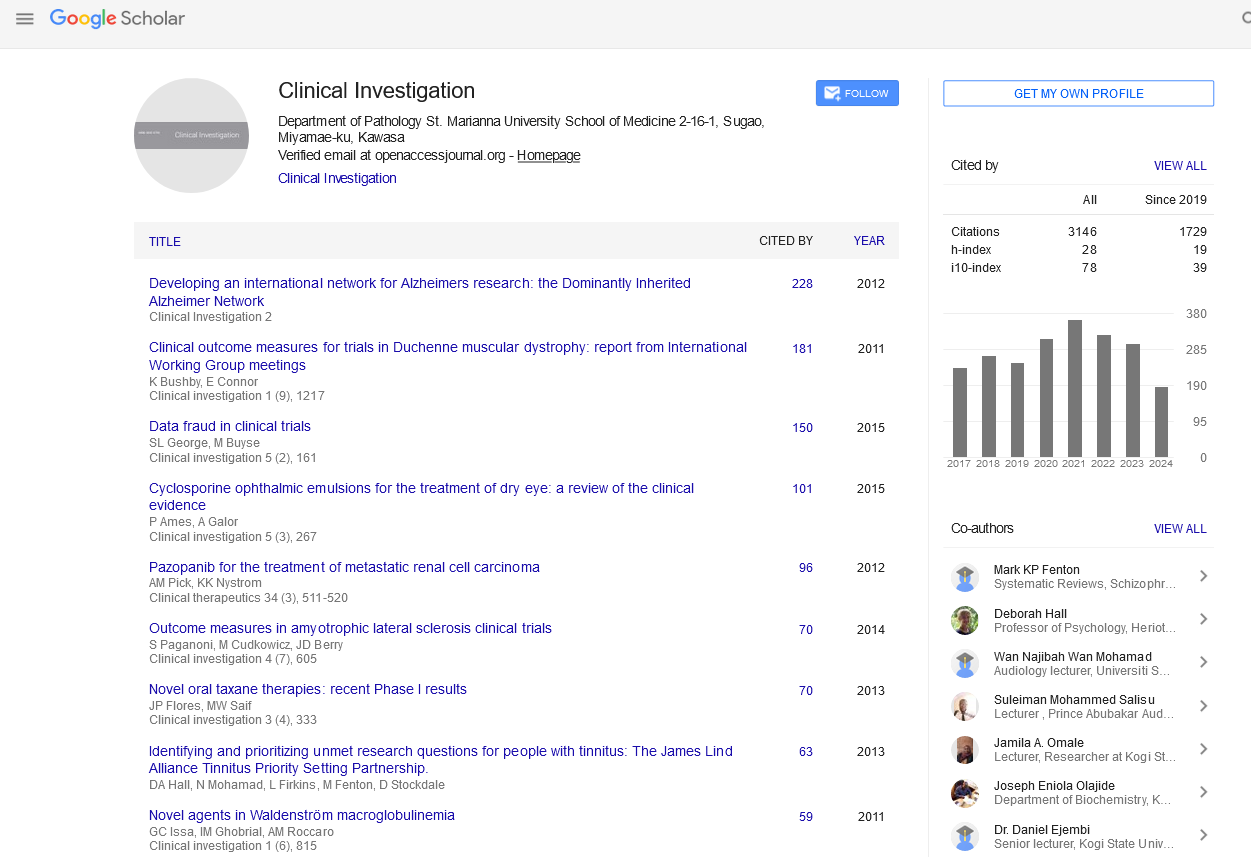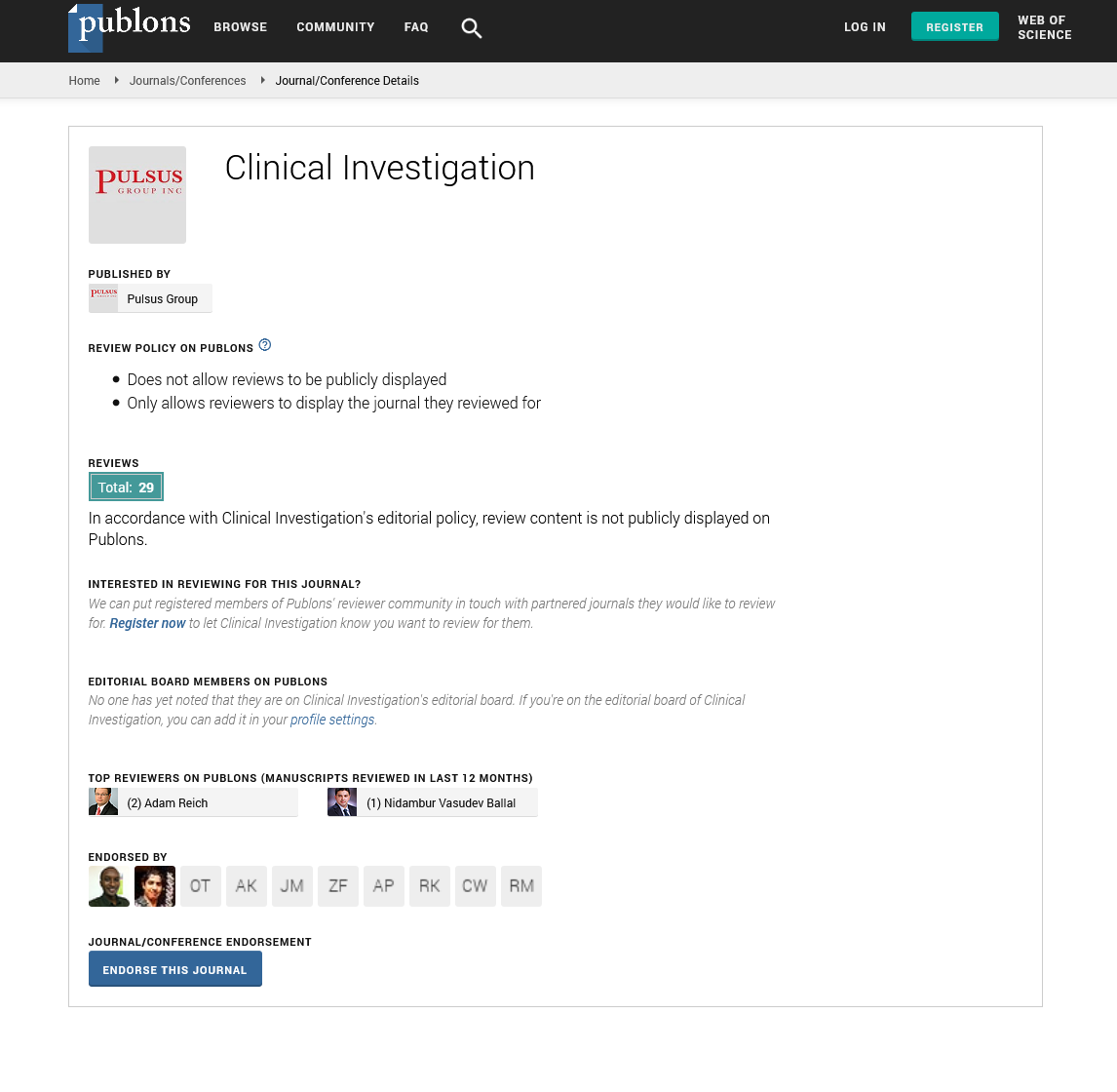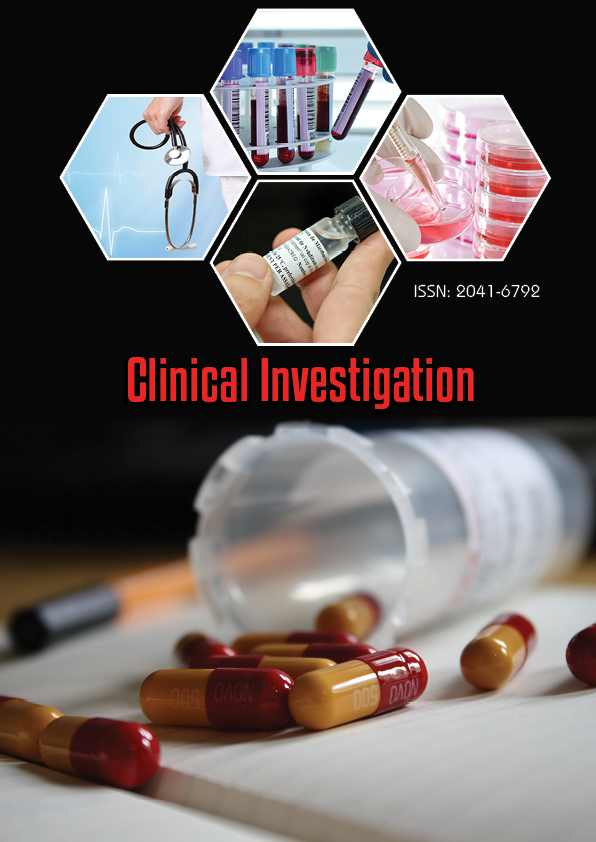Perspective - Clinical Investigation (2024) Volume 14, Issue 4
Amniocentesis: A Vital Diagnostic Tool in Prenatal Care
- Corresponding Author:
- Visu Wati
Faculty of Biology, Federal University of Sao Paulo, Brazil
E-mail: visuwati@gmail.com
Received: 4-April-2024, Manuscript No. fmci-25-160341; Editor assigned: 6-April-2024, PreQC No fmci-25-160341(PQ); Reviewed: 12-April-2024, QC No. fmci-25-160341(Q); Revised: 21-April-2024, Manuscript No. fmci-25-160341(R); Published: 25-April-2024
Abstract
Amniocentesis is a prenatal diagnostic procedure used to assess the health of the fetus and detect certain genetic disorders, infections, and abnormalities. In this procedure, a small sample of amniotic fluid surrounding the fetus is extracted for analysis. While amniocentesis can provide critical information for expecting parents and healthcare providers, it also carries certain risks, such as miscarriage, infection, and injury to the fetus. This article explores the purpose, procedure, advantages, risks, and ethical considerations of amniocentesis. Additionally, it delves into its role in modern prenatal care and the evolution of alternative screening methods. Amniocentesis continues to be an essential tool in the diagnosis and management of fetal health, particularly when the risk of genetic conditions is high.
Keywords
Amniocentesis • Prenatal care • Genetic testing • Fetal health • Prenatal diagnosis • Genetic disorders • Pregnancy complications
Introduction
Pregnancy is an exciting but sometimes uncertain time for expectant parents, particularly when concerns arise about the health of the fetus. For parents who may be at risk of having a child with a genetic disorder or abnormality, obtaining accurate information about the fetus’s health becomes crucial. Amniocentesis, a well-established prenatal diagnostic procedure, plays a key role in providing such information.
Amniocentesis involves the extraction of a small amount of amniotic fluid from the uterus, which contains fetal cells and various chemicals. This fluid is analyzed for a wide range of genetic conditions, infections, and fetal development indicators. The procedure is often recommended for women with specific risk factors, such as advanced maternal age, a family history of genetic disorders, or abnormal results from non-invasive screening tests.
Though amniocentesis offers valuable insights into fetal health, it is not without its risks. The decision to undergo the procedure requires careful consideration of the benefits, potential risks, and ethical implications. This article explores the procedure of amniocentesis, its uses, and its role in modern prenatal care.
What is amniocentesis
Amniocentesis is a medical procedure in which a small sample of amniotic fluid is removed from the sac surrounding the fetus. This fluid contains fetal cells and various biochemical substances, which can be tested for a range of conditions, including genetic disorders, fetal infections, and chromosomal abnormalities. It is typically performed between the 15th and 20th weeks of pregnancy, although in some cases, it may be performed later. The procedure is typically done under ultrasound guidance, ensuring that the needle is inserted into the amniotic sac without causing harm to the fetus. A small amount of fluid—usually about 15- 20 milliliters—is collected, and the sample is sent to a laboratory for analysis. The results can take several days to weeks, depending on the tests being conducted.
Genetic disorders: Amniocentesis is most commonly used to diagnose genetic conditions such as Down syndrome (trisomy 21), cystic fibrosis, and sickle cell anemia. It can also detect other chromosomal abnormalities, such as trisomy 18 (Edwards syndrome) and trisomy 13 (Patau syndrome).
Genetic disorders: Amniocentesis is most commonly used to diagnose genetic conditions such as Down syndrome (trisomy 21), cystic fibrosis, and sickle cell anemia. It can also detect other chromosomal abnormalities, such as trisomy 18 (Edwards syndrome) and trisomy 13 (Patau syndrome).
Fetal lung maturity: Amniocentesis can also assess the fetal lungs' development, which is important when considering the timing of preterm birth.
Neural tube defects: Elevated levels of AlphaFetoprotein (AFP) in the amniotic fluid can indicate neural tube defects like spina bifida or anencephaly.
Sex chromosome determination: For parents who wish to know the biological sex of their child, amniocentesis can determine whether the fetus is male or female, based on the presence of XY or XX chromosomes.
The procedure of amniocentesis
Amniocentesis is usually performed in a clinical setting under sterile conditions, with the assistance of ultrasound to guide the needle's placement and ensure the safety of both the mother and the fetus. The steps of the procedure include:
Preparation: The mother is asked to lie down on an examination table, and the abdominal area is cleaned with an antiseptic solution. An ultrasound scan is conducted to determine the position of the fetus and placenta.
Needle insertion: A thin, hollow needle is then inserted through the mother's abdomen and into the amniotic sac, taking care to avoid any blood vessels or organs. The amniotic fluid is drawn into a syringe through the needle.
Post-Procedure: After the fluid is collected, the needle is removed, and the mother is monitored for any immediate complications. The procedure typically lasts about 20 minutes, but the entire visit may take longer.
Laboratory analysis: The collected amniotic fluid is sent to a laboratory where it is analyzed for genetic abnormalities, infections, and other markers. Depending on the complexity of the tests, results can take from several days to a few weeks.
Advantages of amniocentesis
High diagnostic accuracy: Amniocentesis provides highly accurate results, especially when testing for genetic disorders. The analysis of fetal DNA allows for definitive diagnoses of conditions like Down syndrome, cystic fibrosis, and sickle cell anemia, among others.
Early detection of abnormalities: For women with risk factors such as advanced maternal age or a family history of genetic disorders, amniocentesis provides a way to detect potential issues early in the pregnancy, allowing for better decision-making and planning.
Safe and reliable for certain conditions: When performed by an experienced professional, amniocentesis is generally considered a safe procedure for obtaining critical information about fetal health. It is particularly effective in confirming suspected genetic conditions identified through non-invasive screening tests, such as blood tests or ultrasounds.
Risks and limitations of amniocentesis
Miscarriage: Although rare, amniocentesis carries a small risk of miscarriage, estimated at approximately 1 in 300 to 1 in 500 procedures. This risk is higher when the procedure is performed later in pregnancy.
Infection: As with any invasive procedure, there is a risk of infection at the site of the needle insertion. Infection can lead to serious complications, including preterm labor.
Injury to the fetus: Although extremely rare, there is a potential risk of injury to the fetus from the needle, particularly if the fetus is in an unusual position or if the procedure is not performed carefully.
Inconclusive results: While amniocentesis is highly accurate, there are situations where results may be inconclusive or require further testing. Additionally, some genetic conditions may not be detectable through this method.
Emotional and ethical considerations: The decision to undergo amniocentesis can bring emotional stress, particularly if abnormal results are found. Couples must also consider the ethical implications of how to proceed if a serious genetic disorder is detected.
Alternative methods for prenatal testing
In recent years, Non-Invasive Prenatal Testing (NIPT) has emerged as an alternative to amniocentesis. NIPT involves analyzing small fragments of fetal DNA that are present in the mother’s blood. This method is highly accurate for detecting conditions like Down syndrome and carries no risk of miscarriage. However, NIPT is primarily a screening test and cannot provide definitive diagnoses like amniocentesis.
Another alternative is Chorionic Villus Sampling (CVS), a procedure similar to amniocentesis but performed earlier in pregnancy (around 10-13 weeks). CVS involves taking a sample of tissue from the placenta to test for genetic disorders. While CVS is effective for detecting many of the same conditions as amniocentesis, it carries a slightly higher risk of miscarriage.
Conclusion
Amniocentesis remains a vital tool in prenatal care, providing valuable insights into fetal health, especially when there are concerns about genetic disorders, fetal infections, or other abnormalities. While the procedure carries some risks, including miscarriage and infection, its accuracy in diagnosing conditions like Down syndrome and cystic fibrosis makes it an essential option for many expectant parents.
As prenatal screening technology continues to evolve, non-invasive methods like NIPT may offer alternative options for some women, but amniocentesis will likely continue to play a central role in providing definitive diagnostic results. Ultimately, the decision to undergo amniocentesis should be made with careful consideration of the risks, benefits, and personal circumstances, ensuring that expecting parents have all the information they need to make informed choices for the health and well-being of their child.


